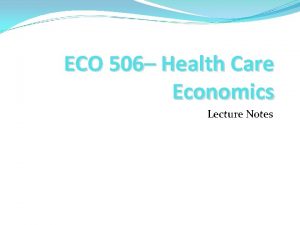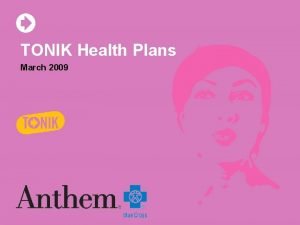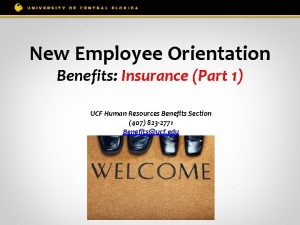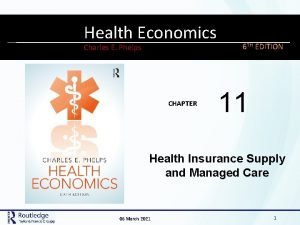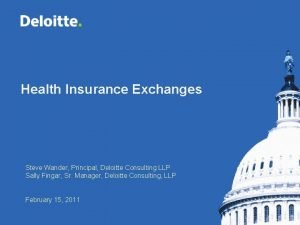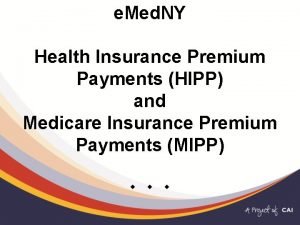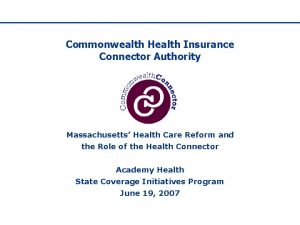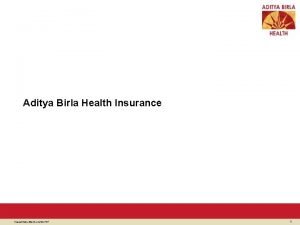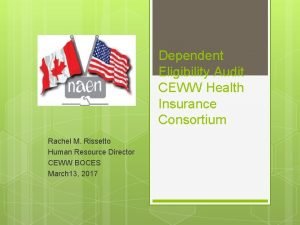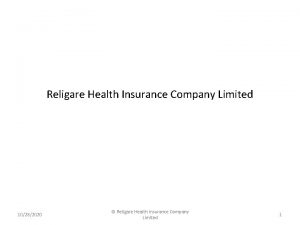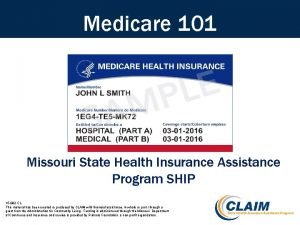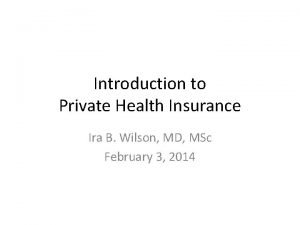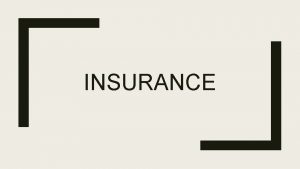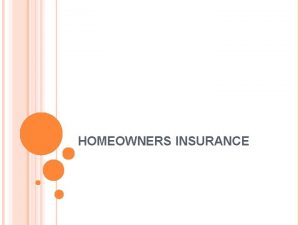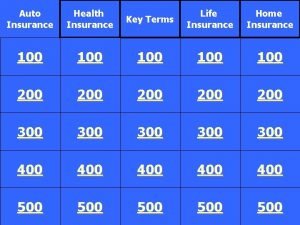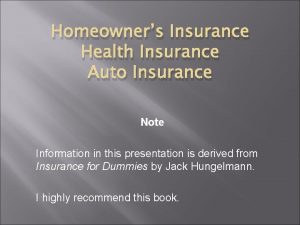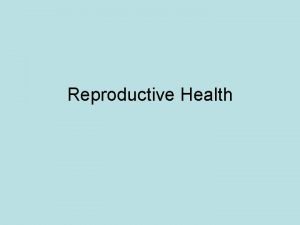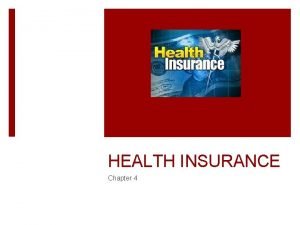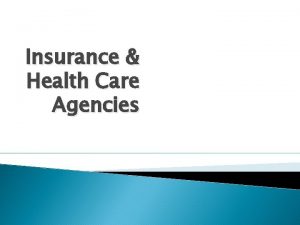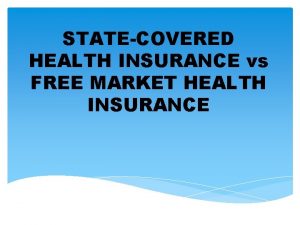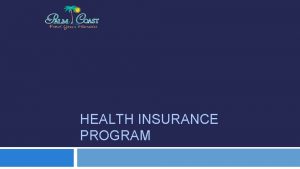Lecture 7 Health Insurance What is Insurance Meant







![Demand for Private Health Insurance Expected Value: E[income if heads]=Prb. H*$1+Prb. T*0=1 Actuarially fair Demand for Private Health Insurance Expected Value: E[income if heads]=Prb. H*$1+Prb. T*0=1 Actuarially fair](https://slidetodoc.com/presentation_image/3a96b7442a1a1e0648cf3ca1546a1e13/image-8.jpg)


















- Slides: 26

Lecture 7 Health Insurance

What is Insurance • Meant to insure us against random uncertainty. • Club of 100 members. • On average, each year one member gets sick, it costs $20, 000. It is random who gets sick. • This is a lot of money for one person to pay. • Instead, they insure each other and each pay $200 a year.

What is Insurance • Aim of insurance is to reduce the variability in one’s income by pooling risks with a large number of people. • Outlays for health may be variable for one person, they are fairly predictable for the group. • Health insurance would not be necessary if everyone had average needs. But we do not it is variable. • Insurance makes it possible to obtain health care without going Bankrupt (new cancer drug $100, 000 a year).

Concentration of Personal Health Expenditures All Top 1% 285, 000 2, 850 Middle Bottom (75%) 213, 75 42, 750 0 Perso ns (000 s) Health 1, 545, 9 4, 36, 4 455, 70 7, 730 $ 00 00 0 million s Source: Getzen T. “Health Economics: Fundamentals and Flow of Funds Per 5, 427 153, 12 2, 135 184 Person 6

History of Private Health Insurance • Modern private health insurance started in 1929. – Baylor University in Dallas began accepting premiums from local school teachers to cover any medical services provided at the University hopsital. • During great depression of 1930 s other hospitals followed. • American Hospital Association created and organized several plans, Blue Cross, and gave subscribers free choice of hospitals within a city. – Premiums determined by community ratings.

History of Private Health Insurance • Hospital insurance market expanded during WWII – Gov’t imposed price and wage controls to curb inflation. – Only way employers could attract new workers was with fringe benefits. So offered private health insurance. – These fringe benefits were not reported to IRS (taxexempt) – IRS eventually asked them to be included in wage bill – Workers expressed alarm and congress passed the health insurance could remain tax exempt.

Actuarially Fair Gamble and Risk Aversion Consider the gambling game: – Zan and Forest flip a coin. – If it comes up heads, Zan wins a dollar and Forest nothing. – If it comes up tails, Forest wills a dollar and Zan nothing. – How much should they each be will to pay to play this game? • Expected Return for Zan: P(head)*$1 + P(tails)*0=. 50 (50 cents).
![Demand for Private Health Insurance Expected Value Eincome if headsPrb H1Prb T01 Actuarially fair Demand for Private Health Insurance Expected Value: E[income if heads]=Prb. H*$1+Prb. T*0=1 Actuarially fair](https://slidetodoc.com/presentation_image/3a96b7442a1a1e0648cf3ca1546a1e13/image-8.jpg)
Demand for Private Health Insurance Expected Value: E[income if heads]=Prb. H*$1+Prb. T*0=1 Actuarially fair gamble: is one in which the amount you pay for the gamble is equal to the expected value of the gamble. • You paid a dollar to play, and you expected value of the game was a dollar.

Demand for Private Health Insurance • If price of gamble (amount pay to play game) is equal to the expected return, then the gamble is actuarially fair. • In health, if expected benefit payment is equal to premiums, the insurance policy is actuarially fair. • Now suppose the gamble was instead for $5, 000, would you want to play the game? – If not you are defined as being risk averse, because you do not want to take the actuarially fair gamble.

Demand for Private Health Insurance Factors affecting demand for health insurance: 1. Loading fee 2. Probability of illness 3. Magnitude of loss relative to income 4. Degree of risk aversion

Moral Hazard • What are the effects of the new price system (with insurance) on demand for insurance. • Buying insurance lowers the price per unit of health care service at time it is bought. • Person with health insurance is more likely to go to the doctor for a small problem than someone without health insurance

Moral Hazard: refers to the increased usage of services when the pooling of risks lead to decreased marginal costs for services. (i. e the price is reduced). • It is also used to refer to how one changes behavior when they are insured. – We may take more risks, which could have health care implications when insured rather than not insured. – Learning snow boarding (lot of people break their arms). May not learn if don’t have health insurance.

Moral Hazard Price Po Amount paid by consumer With insurance Qo Q 1 “Moral Hazard” increase in consumption due to insurance Quantity

Moral Hazard Price D 1 Moral Hazard: D 2 • Increase when the price elasticity of demand increases. Po Amount paid by consumer With insurance Qo. Q 2 Q 1 Quantity

Moral Hazard • For services that are not very price sensitive, insurance will not cause them to purchase more services. – E. g. purchase of insulin for diabetics. • For those that are price sensitive (cosmetic surgery – not from accidents), insurance will cause us to buy more or them

Moral Hazard • Hypothesize about services covered by insurance: services for hospitals and surgery (not cosmetic) more likely to be insured than nursing home care, physical therapy, mental health care, dentistry. • Exchange has to make both groups better off, moral hazard reduces the value of transacting.

Adverse Selection • This theoretical idea comes from arrow 1963 article. • Risk pooling works b/c everyone in the group is at risk and therefore has an interest in making sure that solid insurance benefits are provided. • Suppose the risk was not random, you knew you had a higher chance of lung cancer because smoked all your life. – You would want to make sure you had health coverage and may be willing to pay more for it.

Adverse Selection • Or suppose you never smoked, eat well, do exercise, so think there is a low chance of getting lung cancer. – You would not want to pay a lot for health insurance for lung cancer. • If the high risks are something the insurance company can observe in advance, they can adjust premiums up or down to account for varying risk. – e. g pricing by age is common $300 a month for <=35 and $650 for 51 -60 year olds.

Adverse Selection • Adverse selection occurs when some factors are known to the insured by not to the insurer. – i. e. there is asymmetric information • Example: suppose have n people all with the same demographic characteristics. – First person expected health expend. Is $0 – The other expect to pay as described on following graph.

Adverse Selection Probability 1/n 0 1/4 M 1/2 M 3/4 M 1 M Health Expenditures ($)

Adverse Selection • Insurance company know distribution of health expenditures by person. • People know exactly what they will have to pay. • How much should insurance company charge? – Suppose set price of insurance at $0 • Everyone will sign up. • Insurance company expects to pay out $1/2 M, so will require a premium of at least $1/2 M.

Adverse Selection – So suppose try to set the price of insurance at $1/2 M • Those who know their expenditures are less than 1/2 M will choose to self-insure and will not sign up for the program. • Once they leave the market, the expected amount insurance company will have to pay is $3/4 M, so premium will need to be this much. • But then others will drop out of the market. • Infact if adverse selection is very bad, there may be no health insurance offered!

Adverse Selection • This is why insurers try to mitigate the problem of adverse selection: – Some do it in devious ways like putting on office on the second floor in a building with no elevator. – Premiums are often based on pre-existing conditions, age, employment status, occupation. • They may also try to do group experience rating, since it is easier to figure out what will happen on average for the group than

Problems with Health Insurance Mkt (Cutler, 1994) He argues: 1. Health system fails to provide full coverage or finance this coverage appropriately. – Due to moral hazard cover catastrophic risks, but not lower-risk patients. – Due to adverse selection, do not want to insure preexisting conditions. – 80% of conventional insurance plans set a max. lifetime payment (250, 000 – 1 million) – Concludes that many individuals are not covered for large financial risk.

Problems with Health Insurance Mkt (Cutler, 1994) 2. Insurance is over “experience rated” – 3 types of health care costs. • Those individuals can control (smoking) • Costs that are not controllable but predictably related to characteristics of the group (age). • Costs which are truly random factors (for unforseen diseases or accidents). – He suggests that costs that individual costs should be experience rated to ensure people face the true cost.

Problems with Health Insurance Mkt (Cutler, 1994) – For predictable but uncontrollable costs it is essentially a distributional issue (should the young subsidize the old) – For random costs, it is natural to pool costs. • For individual or employees of small firms there premiums are large and variable often making them unsustainable. • He argues for community ratings- charge everyone the same rate based on age or location. • But the bigger the pool of people the better, so why stop at community?
 01:640:244 lecture notes - lecture 15: plat, idah, farad
01:640:244 lecture notes - lecture 15: plat, idah, farad Features of fire insurance
Features of fire insurance Healthmis.ng
Healthmis.ng Health economics lecture notes
Health economics lecture notes Ttuhsc counseling center
Ttuhsc counseling center Fau health insurance
Fau health insurance Umms benefits
Umms benefits Blue cross tonik plan
Blue cross tonik plan Ouhsc student health
Ouhsc student health Raksha tpa network hospital list
Raksha tpa network hospital list Susorp valic
Susorp valic Health insurance market segmentation
Health insurance market segmentation Deloitte health insurance
Deloitte health insurance What is deductible in health insurance
What is deductible in health insurance Hipp program ny
Hipp program ny Commonwealth health insurance connector authority
Commonwealth health insurance connector authority Chapter 14 health disability and life insurance
Chapter 14 health disability and life insurance Aditya birla nuvo health insurance
Aditya birla nuvo health insurance Uw madison health insurance
Uw madison health insurance Statewide health insurance benefits advisors
Statewide health insurance benefits advisors Paramount health insurance
Paramount health insurance Ceww health insurance consortium
Ceww health insurance consortium Religare health insurance franchise
Religare health insurance franchise Missouri state health insurance assistance program
Missouri state health insurance assistance program Ira b wilson
Ira b wilson Whirlpool health insurance
Whirlpool health insurance Pace university health insurance
Pace university health insurance



